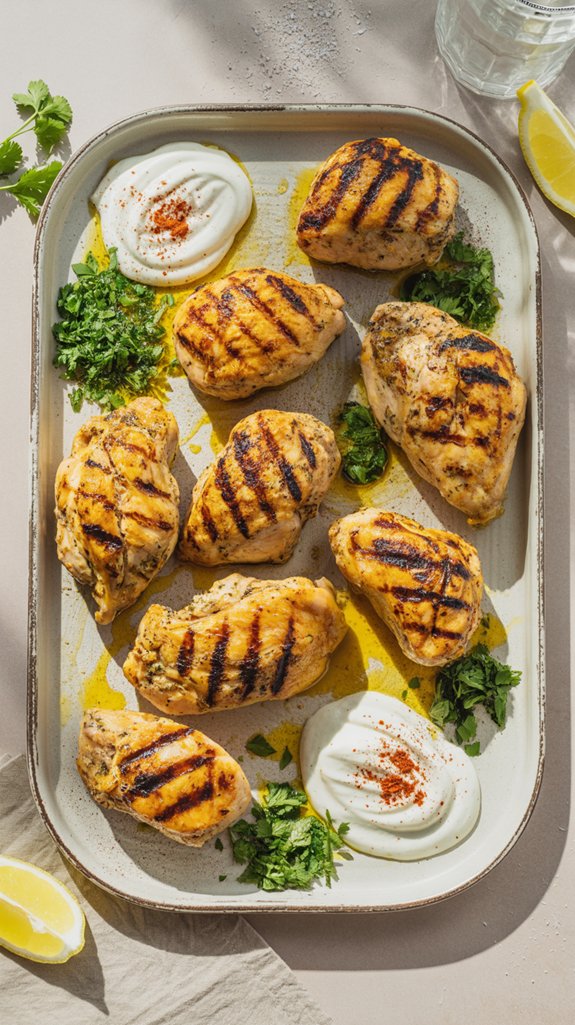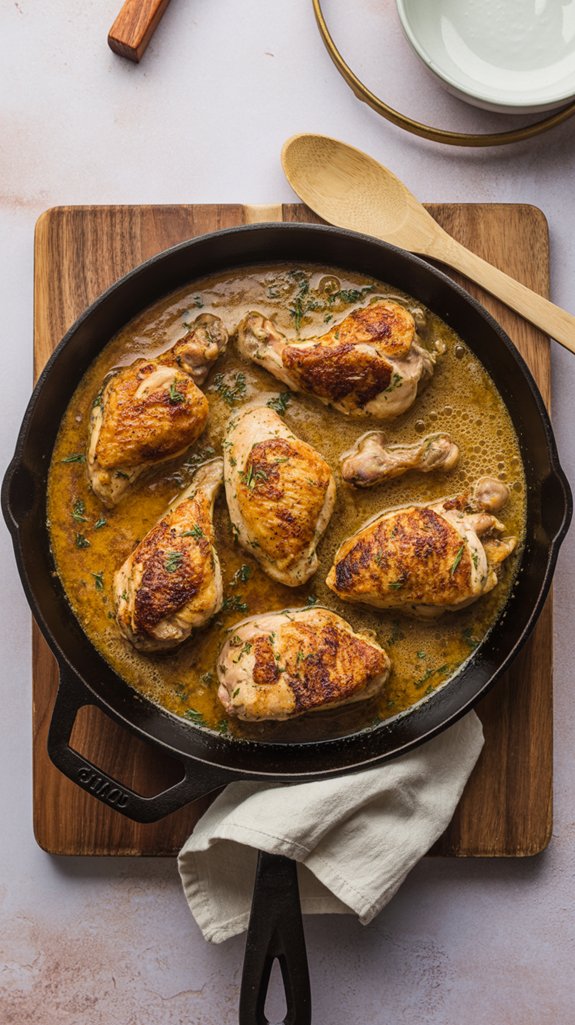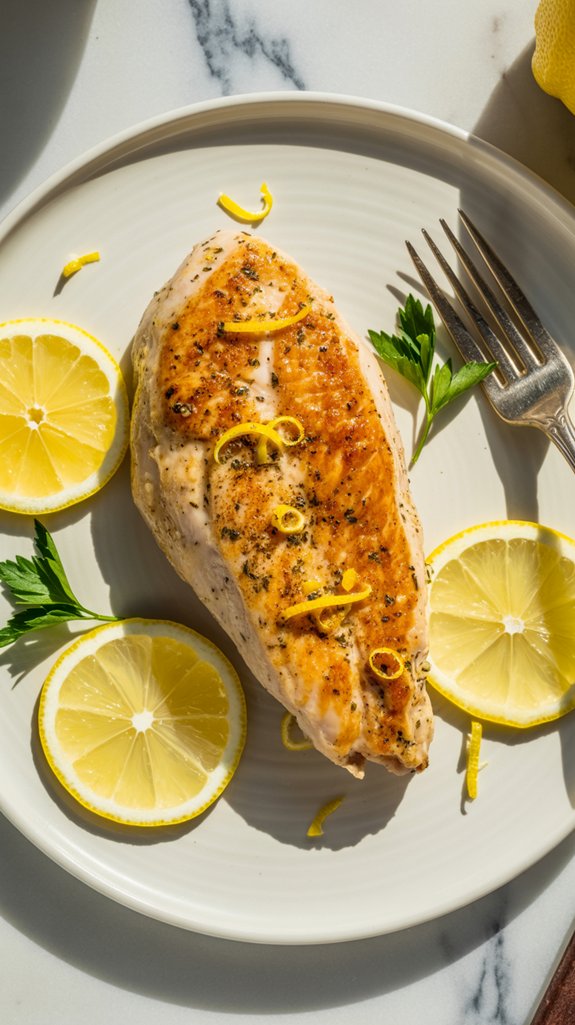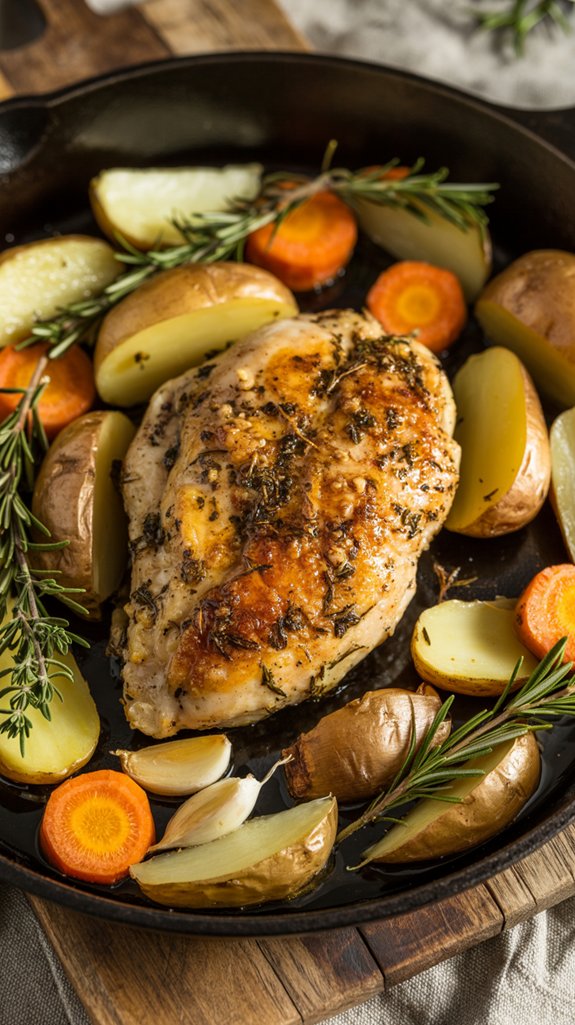Why You’ll Love This this Creamy Overnight Yogurt-Marinated Chicken
This overnight yogurt marinade transforms ordinary chicken breasts into something that’s practically fall-off-the-bone tender, with that tangy brightness from the lemon juice cutting through all that rich, buttery goodness.
You get this amazing crispy, golden crust on the outside while the inside stays incredibly moist – and honestly, who doesn’t love a recipe that does most of the work while you’re sleeping.
The best part is how the yogurt acts like a magic tenderizer, breaking down those tough fibers so even the most stubborn chicken breast turns out juicy every single time.
Ingredients List
The beauty of this recipe is that you probably have most of these ingredients hanging out in your kitchen right now, just waiting to create something magical.
- 3 whole chicken breasts (boneless, skinless work perfectly)
- 1 cup plain yogurt
- 2 tablespoons lemon juice
- 2 garlic cloves, minced
- 2 teaspoons celery salt (or celery seeds if that’s what you’ve got)
- 2 teaspoons salt
- 1/4 teaspoon pepper
- 1 cup dry breadcrumbs
- 1/2 cup butter, melted (margarine works too)
Quick ingredient considerations that’ll make you feel good about this dish:
- Plain yogurt brings probiotics to the party, which your gut will thank you for
- Garlic isn’t just flavor – it’s basically nature’s little antibiotic powerhouse
- You can easily swap the butter for a healthier oil or stick with margarine to keep things lighter
- The lemon juice adds vitamin C while helping tenderize the meat naturally
- Using boneless, skinless breasts keeps the protein high and the calories reasonable
Step by Step Directions
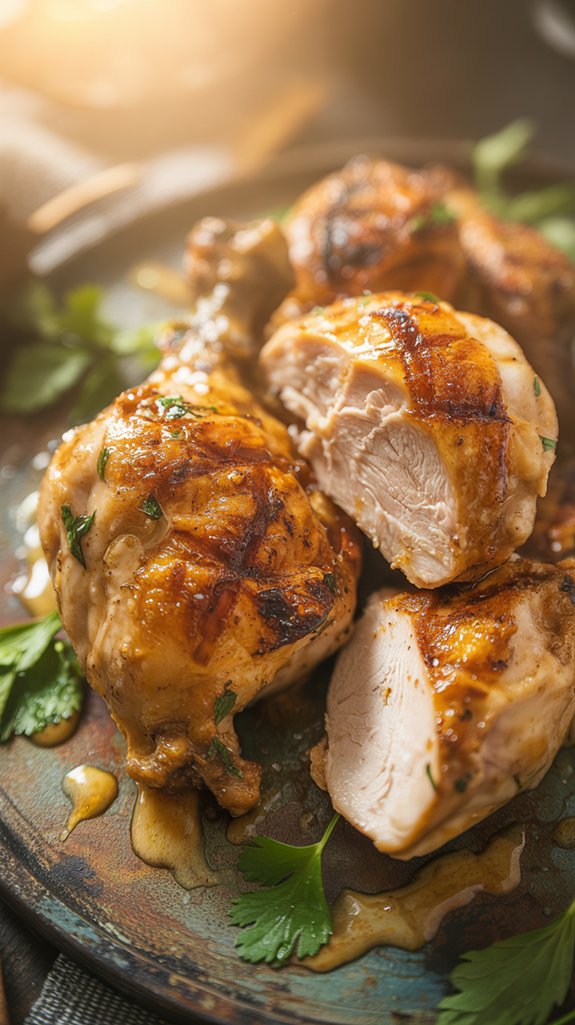
Making this overnight yogurt-marinated chicken is straightforward and delivers incredibly tender, flavorful results that are worth the patience.
- Rinse chicken breasts thoroughly and pat completely dry with paper towels.
- Combine yogurt, lemon juice, minced garlic, celery salt, salt, and pepper in a rimmed, flat bowl and stir until well mixed.
- Roll each chicken breast in the yogurt marinade, ensuring all surfaces are coated.
- Place marinated chicken in a container and refrigerate overnight (you can cook immediately, but overnight marinating produces superior results).
- Remove chicken from refrigerator and coat each piece thoroughly with dry breadcrumbs.
- Place breaded chicken pieces on a greased baking tray, spacing them evenly.
- Spoon half of the melted butter over the breaded chicken pieces.
- Bake exposed at 350°F for approximately 45 minutes or until nearly cooked through.
- Remove from oven and spoon the remaining melted butter over the chicken.
- Continue baking until chicken is completely tender and cooked through (internal temperature should reach 165°F).
For an extra burst of flavor, freshly grind your spices using a professional spice grinder to ensure maximum potency and aroma in your marinade.
Substitutions and Variations
- Spice it up options – Add paprika, cayenne pepper, or your favorite seasoning blend to the breadcrumb mixture, especially if your family thinks regular chicken is about as exciting as watching paint dry.
- Chicken thigh alternative – Use bone-in thighs instead of breasts for more flavor and forgiveness if you accidentally overcook them, plus they’re usually cheaper at the store.
- Herb crust variation – Mix dried Italian herbs, garlic powder, and a little grated lemon zest into your breadcrumbs for a Mediterranean twist that sounds way fancier than it actually is.
Additional Things to Serve With This Dish
This yogurt chicken plays well with pretty much anything you’ve got hanging around your kitchen, which is frankly one of its best qualities.
- Rice or grain sides – Plain white rice, wild rice pilaf, or quinoa all soak up those lovely pan drippings that somehow always taste better than they’ve any right to. Brown rice works too if you’re feeling particularly virtuous about your carb choices.
- Roasted vegetables – Toss some carrots, Brussels sprouts, or green beans with olive oil and throw them in the oven alongside the chicken, because why dirty another pan when you’re already committed to this whole baking situation?
- Simple salads – A basic mixed green salad with vinaigrette cuts through the richness nicely, or go with a cucumber-tomato situation if you want something that won’t wilt while you’re figuring out if the chicken is actually done yet.
- Potato options – Mashed potatoes are the obvious comfort food choice, but roasted baby potatoes or even a simple baked potato work when you want something that requires zero brain power to execute.
- Bread situations – Dinner rolls, garlic bread, or even just some crusty bread for sopping up sauce, because to be truthful, half the joy of home cooking is having an excuse to eat bread with dinner.
Cooking Tips & Tricks (Chef’s Notes)
A few strategic moves can turn this from decent weeknight dinner into something that’ll have people asking for the recipe.
- Don’t skip the overnight marination – I know it requires actual planning, which feels like asking a lot on a Tuesday, but that yogurt needs time to work its tenderizing magic and those flavors need to get properly acquainted with each other.
- Pat everything dry before breading – Wet chicken plus breadcrumbs equals a soggy, sad coating that’ll slide right off, and nobody wants to explain why half the breading ended up on the baking sheet instead of the chicken.
- Use a meat thermometer instead of guessing – Internal temperature should hit 165°F, because undercooked chicken is nobody’s friend, and overcooked chicken tastes like regret with a side of dry disappointment.
- Let the butter be actually melted, not just softened – Cold butter clumps up and creates uneven coverage, which means some pieces get golden and gorgeous while others look like they’ve been neglected.
- Give each piece some breathing room on the pan – Crowded chicken steams instead of browning, and steamed chicken has all the visual appeal of hospital food from the 1980s.
- Check the bottom rack position – Too high and the tops brown before the inside cooks through, too low and you get pale, anemic-looking chicken that photographs terribly for your inevitable social media post.
Nutritional Facts
This protein-packed dish delivers solid nutrition with the tangy twist of yogurt marinade making it both flavorful and relatively healthy.
- High in protein – Each chicken breast provides approximately 25-30 grams of complete protein, essential for muscle maintenance and keeping you satisfied longer.
- Calcium boost from yogurt – The cup of plain yogurt adds about 300mg of calcium, roughly 30% of your daily needs for strong bones and teeth.
- Lower in calories than fried alternatives – Baked preparation keeps this around 350-400 calories per serving, considerably less than breaded and fried chicken options.
- Good source of B vitamins – Chicken breast is rich in niacin, B6, and B12, which support energy metabolism and nervous system function.
- Moderate sodium content – With the celery salt and regular salt, each serving contains roughly 800-900mg sodium, so watch your intake if you’re monitoring salt.
- Healthy fats from butter – While not low-fat, the melted butter provides fat-soluble vitamins A, D, E, and K that your body needs.
- Probiotics potential – If using live-culture yogurt in the marinade, you might get some beneficial bacteria, though cooking likely reduces their effectiveness.
- Low carbohydrate option – Breadcrumbs add about 15-20 grams of carbs per serving, making this moderate for low-carb diets.
- Selenium and phosphorus – Chicken provides these essential minerals that support immune function and bone health.
Fun “Did You Know?”
While you’re letting that chicken soak up all those tangy yogurt flavors overnight, here’s something fascinating: yogurt marinades actually work as natural meat tenderizers because of their lactic acid content, which breaks down tough protein fibers just like expensive commercial tenderizers do.
I’ve uncovered that Greek yogurt contains even more protein and creates an incredibly thick coating that locks in moisture during baking.
Ancient Persian cooks used this technique over 2,000 years ago, and it’s still popular in Middle Eastern cuisine today.
The longer marination time isn’t just for flavor—it’s pure food science at work!

